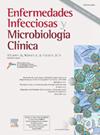GII.17诺如病毒引起的养老院胃肠炎暴发
IF 2.5
4区 医学
Q3 INFECTIOUS DISEASES
Enfermedades infecciosas y microbiologia clinica
Pub Date : 2025-08-01
DOI:10.1016/j.eimc.2024.12.006
引用次数: 0
摘要
胃肠诺如病毒感染非常普遍,尤其在养老院等机构引起疫情。我们描述了由新出现的诺如病毒基因型引起的疫情。材料和方法我们将病例定义为在2022年5月14日至29日期间出现AGE临床体征和症状的中心居民或工作人员,且无基础病理证明。进行了临床流行病学调查,并收集了研究期间腹泻患者的粪便样本。病毒学分析在我院微生物科进行,采用抗原检测(Certest®,Biotec SL)和/或多重PCR (AllplexTM GI-Virus Assay, Seegene®)。病毒基因分型测序由国家中心Microbiología (CNM)进行。结果本次疫情共发生114例(居民99例,工作人员15例),持续16天以上。最常见的症状是呕吐和腹泻。总体发病率为30.8%(工人12.7%)。病例在最初48小时内迅速增加,随后几天逐渐下降。排除了食品污染的可能性,人际传播的可能性最大。受影响的患者在不到72小时内临床好转,无死亡病例。我们对来自居民的14个样本进行了检测,这些样本对诺如病毒i呈阳性。CNM共收到8份样本,其中6份检测到诺如病毒基因组GII,基因型17 [P17]。结论诺如病毒GEA在疗养院的暴发可影响大量使用者。在我们的病例中,诺如病毒基因型GII.17是病原,证实其在过去十年中在世界范围内广泛传播。本文章由计算机程序翻译,如有差异,请以英文原文为准。
Brote de gastroenteritis por norovirus GII.17 en una residencia de mayores
Introduction
Gastrointestinal norovirus infections are highly prevalent, causing outbreaks especially in institutions such as nursing homes. We describe an outbreak caused by an emerging norovirus genotype.
Material and methods
We defined a case as a resident or worker of the centre with clinical signs and symptoms of AGE from 14 to 29 May 2022, with no underlying pathology to justify it. A clinical-epidemiological survey was carried out and stool samples were collected from patients with diarrhoea at the time of the study. Virological analysis was performed at the Microbiology Department of our hospital by antigenic detection (Certest®, Biotec SL) and/or multiplex PCR (AllplexTM GI-Virus Assay, Seegene®). Viral genotyping by sequencing was performed by the Centro Nacional de Microbiología (CNM).
Results
The outbreak totaled 114 cases (99 residents, 15 workers), extending over 16 days. The most frequent symptoms were vomiting and diarrhoea. The overall attack rate was 30.8% (in workers 12.7%). Cases increased rapidly in the first 48 hours, falling progressively over successive days. Food contamination was ruled out, with person-to-person transmission being the most likely. Those affected improved clinically in less than 72 hours, with no deaths. We tested 14 samples from residents, which were positive for norovirus GII. The CNM received 8 samples, detecting norovirus genogroup GII, genotype 17 [P17] in 6.
Conclusions
Outbreaks of norovirus GEA in nursing homes can affect numerous users. In our case, norovirus genotype GII.17 was the aetiological agent, confirming its widespread dissemination in the last decade worldwide.
求助全文
通过发布文献求助,成功后即可免费获取论文全文。
去求助
来源期刊
CiteScore
2.10
自引率
8.00%
发文量
194
审稿时长
29 days
期刊介绍:
Hoy está universalmente reconocida la renovada y creciente importancia de la patología infecciosa: aparición de nuevos agentes patógenos, de cepas resistentes, de procesos con expresión clínica hasta ahora desconocida, de cuadros de una gran complejidad. Paralelamente, la Microbiología y la Infectología Clínicas han experimentado un gran desarrollo como respuesta al reto planteado por la actual patología infecciosa. Enfermedades Infecciosas y Microbiología Clínica es la Publicación Oficial de la Sociedad Española SEIMC. Cumple con la garantía científica de esta Sociedad, la doble función de difundir trabajos de investigación, tanto clínicos como microbiológicos, referidos a la patología infecciosa, y contribuye a la formación continuada de los interesados en aquella patología mediante artículos orientados a ese fin y elaborados por autores de la mayor calificación invitados por la revista.

 求助内容:
求助内容: 应助结果提醒方式:
应助结果提醒方式:


